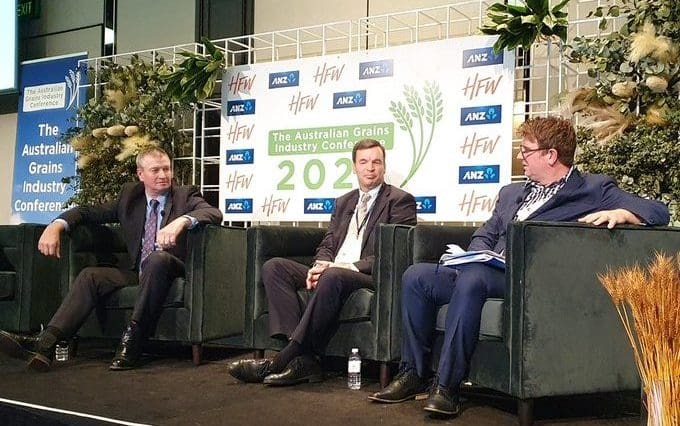
ACM national grains reporter Gregor Heard (right) chairs a discussion on grain pricing with Grain Producers Australia director and Wimmera grower Andrew Weidemann and Emerald Grain CEO David Johnson in Melbourne last year. Photo: AGIC 2022
GRAIN Trade Australia has criticised a call put out last week by farming lobby group GrainGrowers to investigate Australian grain pricing because GrainGrowers has not released its internal report on which the call was based.
As the representative body for grain supply-chain operators and marketers, GTA has been called upon by media to respond to GrainGrowers’ claims made public last week that Australian growers were being underpaid based on world pricing.
“It is difficult to make any comments on something that we have not seen,” Grain Trade Australia chief executive officer Pat O’Shannassy said.
“It would seem a little opportunistic to make substantial claims without providing the evidence upon which they are made”.

GTA CEO Pat O’Shannassy.
GTA said there had been no contact or engagement from GrainGrowers to either discuss or explain the claims in the report, but rather “a rush to the media to capture headlines”.
“In the end, this approach really does the grain sector as a whole a disservice rather than a constructive service.”
“We don’t need an expensive inquiry…but having a collaborative and united industry approach to engage with government to seek to improve the supply-chain constraints would be useful for all”.
Since the deregulation of Australian wheat exports in 2008, GTA said there have been more than 30 inquiries, wheat port code and productivity reports held at both a state and federal level into the grain supply chain.
GTA said these inquiries and investigations have consistently found competition and innovation, with 32 bulk grain export terminals now being operated by 18 companies, up from 18 terminals operated by four companies in 2008, as well as growth in container-packing facilities.
Challenge lies in quantity changes
GTA said the discussion around the grain supply chain and its export capacity has emerged following record crops over the past three seasons which have exceeded the export supply-chain’s capacity to move grain to market within specific timeframes.
GTA has engaged with stakeholders, including growers, on this issue in public and private forums, including a session at last year’s AGIC event.
“The grain export supply chain is moving more grain than ever before in its history.”
GTA said supply-chain operators have a clear understanding of the constraints which are concentrated around moving grain to export terminals, including labour, road and rail transport availability and infrastructure.
It has pointed to improvements which could be made, including:
- Better access to labour and technology;
- Improved port intake through investment in road and rail;
- Reducing container costs and increasing availability.
The underutilisation of assets during years of average and lower production and the cost of excess port and freight assets were highlighted in an independent report in 2020 by consulting firm LEK.
It was commissioned by the Federal Department of Transport and Infrastructure as part of the National Freight and Supply Chain Strategy.
The report looked at Australia’s grain supply-chain port and rail freight costs and compared them with competing countries; since the report’s release, the grain sector has invested further capital and increased capacity within the supply chain.
Even with record crop production and the supply chain constraints, GTA said grower cash prices remain historically high, with independent analysis by Profarmer Australia showing them to be between the eighth and 10th decile.
Source: GTA

HAVE YOUR SAY